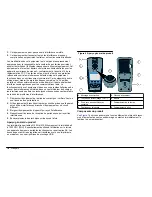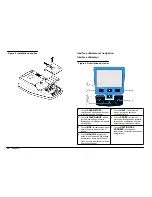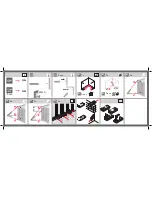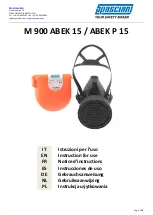
Clean the meter
The meter is designed to be maintenance-free and does not require
regular cleaning for normal operation. Exterior surfaces of the meter may
be cleaned as necessary.
Note: Do not clean the meter with solvents to avoid damaging the material.
1.
Clean the meter with a dust- and lint-free dry or slightly damp cloth. A
mild soap solution can also be used for liposoluble contamination.
Apply silicone oil to a sample cell
Sample cells and caps must be extremely clean and free from significant
scratches. Apply a thin coating of silicone oil on the outside of the sample
cells to mask minor imperfections and scratches that may contribute to
light scattering.
Note: Use only the provided silicone oil. This silicone oil has the same refractive
index as the sample cell glass.
1.
Clean the inside and
outside of the cells and
caps by washing with a
laboratory glass
cleaning detergent.
Follow with multiple
rinses with distilled or
demineralized water.
2.
Apply a small bead of
silicone oil from the top
to the bottom of the cell.
3.
Use the provided
oiling cloth to spread the
oil uniformly. Wipe off
the excess so that only a
thin coat of oil is left.
Make sure that the
sample cell is almost dry
with little or no visible oil.
Note: Store the oiling
cloth in a plastic storage
bag to keep the cloth
clean.
Store the sample cells
N O T I C E
Do not air dry the sample cells.
Note: Always store the sample cells with caps on to prevent the cells from drying.
1.
Fill the sample cells with distilled or demineralized water.
2.
Cap and store the sample cells.
3.
Wipe the outside of the sample cells dry with the a soft cloth.
Replace the battery
W A R N I N G
Potential fire hazard. Use only alkaline or nickel metal hydride batteries (NiMH) in
the meter. Other battery types or incorrect installation can cause a fire. Never mix
battery types in the meter.
For battery replacement refer to
Figure 3
on page 7.
1.
Remove the battery cover.
2.
Remove the batteries.
3.
Install 4 AA alkaline or 4 AA nickel metal hydride (NiMH) batteries.
Make sure that the batteries are installed in the correct orientation.
4.
Replace the battery cover.
Replace the lamp
C A U T I O N
Burn Hazard. Wait until lamp cools down. Contact with the hot lamp can cause
burns.
English
11
Summary of Contents for 2100A
Page 2: ...English 3 Fran ais 16 Espa ol 30 Portugu s 44 58 70 83 2...
Page 12: ...1 2 3 4 12 English...
Page 13: ...5 6 7 8 English 13...
Page 26: ...1 2 3 4 26 Fran ais...
Page 27: ...5 6 7 8 Fran ais 27...
Page 40: ...1 2 3 4 40 Espa ol...
Page 41: ...5 6 7 8 Espa ol 41...
Page 54: ...1 2 3 4 54 Portugu s...
Page 55: ...5 6 7 8 Portugu s 55...
Page 61: ...NiMH NiMH 1 2V 1 5V 2500 mAH 90 AA 10 30 USB 23 1 2 4 AA 4 AA NiMH 3 23 61...
Page 62: ...24 1 5 2 6 3 7 4 ID ID 25 25 1 ID 9 NTU FNU 2 ID 10 3 11 4 12 5 13 6 14 7 15 8 16 62...
Page 63: ...1 2 3 4 1 2 1 2 24 12 24 12 24 12 ID ID ID 1 ID 2 ID ID ID ID ID ID ID ID ID ID ID ID 63...
Page 65: ...1 1 2 3 1 2 3 NiMH 23 61 1 2 3 4 AA 4 AA NiMH 4 65...
Page 66: ...1 2 3 4 66...
Page 67: ...5 6 7 8 67...
Page 69: ...69...
Page 72: ...1 2 3 4 5 2100Q 2100Qis 0 1000 NTU FTU 4 AA USB 26 1 5 2 6 3 7 4 8 27 72...
Page 74: ...28 29 1 5 UP 2 6 RIGHT 3 DOWN 7 4 LEFT 74...
Page 78: ...1 2 3 1 2 3 NiMH 28 74 1 2 3 4 AA 4 AA NiMH 4 78...
Page 79: ...1 2 3 4 79...
Page 80: ...5 6 7 8 80...
Page 82: ...USB USB USB 1 USB 2 3 82...
Page 86: ...NiMH NiMH 1 5 V NiMH 1 2 V 2500 mAH NiMH 90 AA NiMH 10 30 USB 33 1 2 AA 4 AA NiMH 4 3 33 86...
Page 91: ...33 86 1 2 3 AA 4 AA NiMH 4 4 91...
Page 92: ...1 2 3 4 92...
Page 93: ...5 6 7 8 93...
Page 95: ...95...
Page 96: ...www hach com Hach Company 2010 All rights reserved Printed in the U S A 01 2010 Edition 1...












































